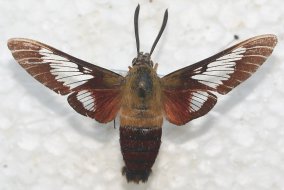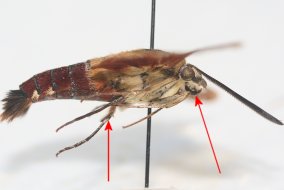Bee Mimics
What is (and isn't) a bee?
Take a look at the three pictures below, and try to identify which are bumble bees and which are honey bees:
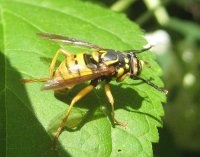
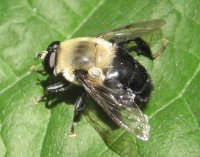
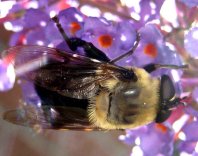
If you didn't pick any of them - good job! None of the insects pictured
above are bees, but actually flies that are mimicking bees (or, in the
case of the first picture, mimicking a wasp).
Thanks to cartoons and advertisements (not to mention the pain of an unexpected
sting), bees are well-known insects in the public mind. And as a result,
when most people think of a bumble bee or a honey bee, they're not too far
off-target. These bees are flying insects, often hairy, and can have black
and yellow stripes. They live in colonies, defend themselves with a stinger,
and harvest pollen from flowers.
However, bumble bees and honey bees represent only a handful of the bee species in the world, or even Illinois. With all this diversity, it becomes easy to confuse bumble or honey bees with many other kinds of bees, or their close relatives, the wasps. To make things even more difficult, many insects like the ones pictured above will try very hard to imitate bees (we call them bee mimics), and they do a surprisingly good job of it! To differentiate between bees and their many mimics, it becomes necessary to know a little more about these insects than just their colors and general shape.
Identifying Bumble Bees and Honey Bees
Honey bees and bumble bees share many features, but it's not too hard to tell them apart. For a detailed description of these two insects, check out our Bee Biographies. If you don't want to get too technical, just keep a few things in mind:
- Honey bees have black and orange-yellow stripes, while bumble bees have black and vivid yellow stripes.
- Bumble bees can appear a little furrier than honey bees.
- Bumble bees are generally larger and have heavier bodies.
Below are some detailed pictures. The following images show a honey bee
(left) and a bumble bee (right).
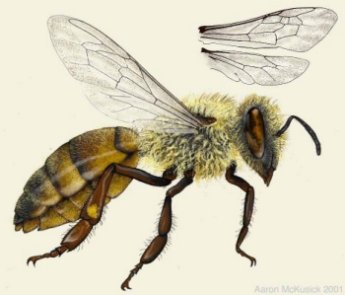
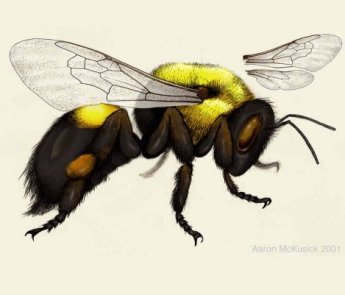
(Above images courtesy of
the University of Maine Cooperative Extension)
These images probably look familiar, but they also illustrate many specific features
of bees that you may not be familiar with. The sections below will touch
on these features, and what about them is unique to bumble bees and honey bees,
or bees in general. Learning them will enable you to differentiate between
these two bees and the many other similar insects.
The Parts of a Bee
The Antennae
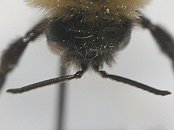
Antennae in insects come in a variety of shapes and sizes. Bumble bees and honey bees have what are called elbowed antennae, which bend at a joint in the middle, as would a human arm.
The Wings

Most insects have two pairs of wings, and this includes all bees. This is an important feature to recognize; many flies are disguised as bees, but flies only have one pair of wings.
The Body
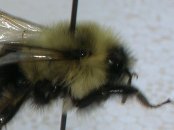
The body of a bumble bee or honey bee is covered in thick hair, making them appear quite fuzzy. This can be a useful way to tell between bees and wasps.
The Mouthparts
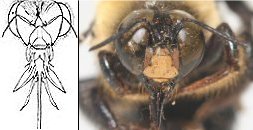
Bees have a unique type of mouth that has the usual insect mandibles (jaws), but also a long tongue. These mouthparts can be difficult to see unless the bee is stationary and feeding, but it is an important difference between bees and all other insects.
The Legs
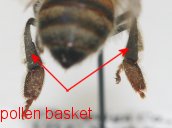
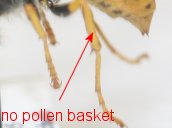
The hind legs of the honey bee and bumble bee hold the most important difference between these and all other kinds of Illinois bees. Look to the images in this section, and at the enlarged section indicated by the arrows. This is the pollen basket, a hairy, concave (spoonlike) section of the leg where the bees pack pollen they collect from flowers. A few other tropical bees have this leg, but in Illinois, you will only see it on bumble bees and honey bees. Keep in mind that the other enlarged section, below the pollen basket, may be present on other bees. Additionally, male bees do not have pollen baskets, so you must use other features to identify them.
Identifying Bumble Bee and Honey Bee Lookalikes
Now that you're familiar with bumble bees and honey bees, we'll list the other insects that can resemble them. To help summarize the differences, every group of similar insects will have a chart like the one to the right, with icons of the antennae, wings, mouthparts, body, and legs. The icons in the green column are shared between honey bees, bumble bees, and the current insect. The red column shows where to look for the difference.
Other Bees
Bumble bees and honey bees are not the only two bees in Illinois. Leaf-cutting bees, sweat bees, carpenter bees, and many others are frequent visitors to flowers - see the section on solitary bees if you're curious. The only surefire difference is the presence of the pollen basket.
- SHARED
- Antennae

- Hairy Body

- Wings

- Mouthparts

- UNSHARED
- Legs

Carpenter bees are commonly confused with bumble bees. One easy way to tell the difference is to look at the abdomen. If the abdomen is shiny and not hairy, you probably have a carpenter bee. Carpenter bees may also have much larger heads, proportionally. The pictures below compare a carpenter bee (on the left in each picture) to a bumble bee (right).
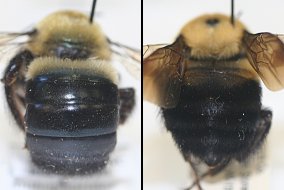
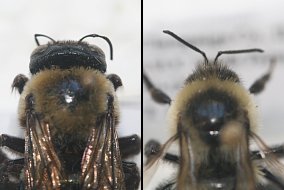
Wasps
Many wasps have striking black and yellow colors and elbowed antennae. However, wasp species often lack the hairy thorax and abdomen. As always, when in doubt, check for the pollen basket.
- SHARED
- Antennae

- Wings

- UNSHARED
- Hairy Body

- Mouthparts

- Legs

Yellow jackets are a species of wasp that you may find on your foods at picnics, or flying near trash cans. These can appear to be honey bees at first glance, but they are a much brighter yellow and lack visible hair on the body. The picture below compares a yellow jacket (left) to a honey bee (right).
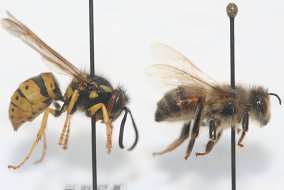
Bee Mimics
Bee mimics are, simply put, other insects that resemble bees. This is called Batesian mimicry, which just means something harmless is imitating something dangerous.
The insects below may look like bees, but they cannot sting (though some may nip or bite!). Luckily for entomologists, no mimic is perfect. Below we'll take a look at different insects in Illinois that pose as bees, and the ways in which their mimicry is incomplete.
Flies
Flies are one of the most common bee mimics in Illinois, and often very well disguised. Even so, there are two simple ways to tell a fly mimic from a bee. First, look at the wings: bees have four wings, but flies have two wings. Second, look at the antennae: bees have elbowed antennae, while many flies have short, stubby, or hair-thin antennae. If you can't see the antennae, you're probably looking at a fly.
- SHARED
- Hairy Body

- UNSHARED
- Antennae

- Wings

- Mouthparts

- Legs

Drone flies, or hover flies, look and sound very similar to bees. When flying, their wings and antennae can be very difficult to observe - but their behavior will be very different from a bee. These flies hover and move erratically; bees generally move slowly from flower to flower, and do not hover in one place. The picture on the left shows the wings of a bee (right) compared to a fly (left). The other picture shows a very convincing bee mimic; however, notice the short, stubby antennae.
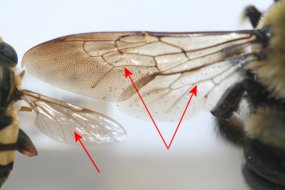
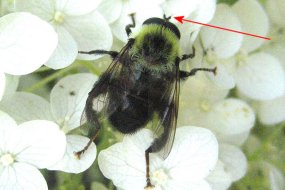
Beetles
A few beetles in Illinois may look similar to bees. However, beetles can always be recognized by the presence of elytra, or hardened forewings. Think of a June beetle or Japanese beetle - the shell on their back is actually the first pair of wings. The second pair of wings are kept underneath the elytra, and only extended when the beetle flies. Bees, on the other hand, have four thin, translucent wings, all intended for flight.
- SHARED
- Body Color Only!

- UNSHARED
- Antennae

- Wings

- Mouthparts

- Legs

Painted Locust Borers are beetles with black and yellow stripes that are very common on goldenrod in the late summer. While flying, these and other related beetles can appear to be bees or wasps. However, when placed side-by-side with bees, it is clear that they share little other than color.
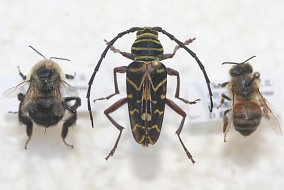
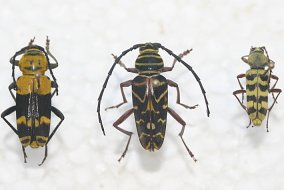
Moths
Many day-flying moths also mimic bees for protection. These moths can share almost all of the superficial features of a bee: four wings, thickened antennae that can appear elbowed, and a furry, black-and-yellow coloration. The trick for seeing through these mimics is looking at the legs, and, if you can see it, the mouth. Moth legs are very slender, and clearly lack a pollen basket. The mouthparts of a moth consist of a long, slender tube (the proboscis), often equal to or greater than the length of the moth itself. This is held coiled under the head, but will elongate when the moth feeds.
- SHARED
- Hairy Body

- Wings

- UNSHARED
- Antennae

- Mouthparts

- Legs

Clear-winged Sphinx Moths are bee mimics and day-flying visitors to many gardens. These moths move and hover over flowers like a hummingbird, rarely landing as they suck nectar. Bees, on the other hand, will always land on a flower to feed or gather pollen. In the pictures below, the arrows indicate the different mouthparts and lack of pollen basket.
